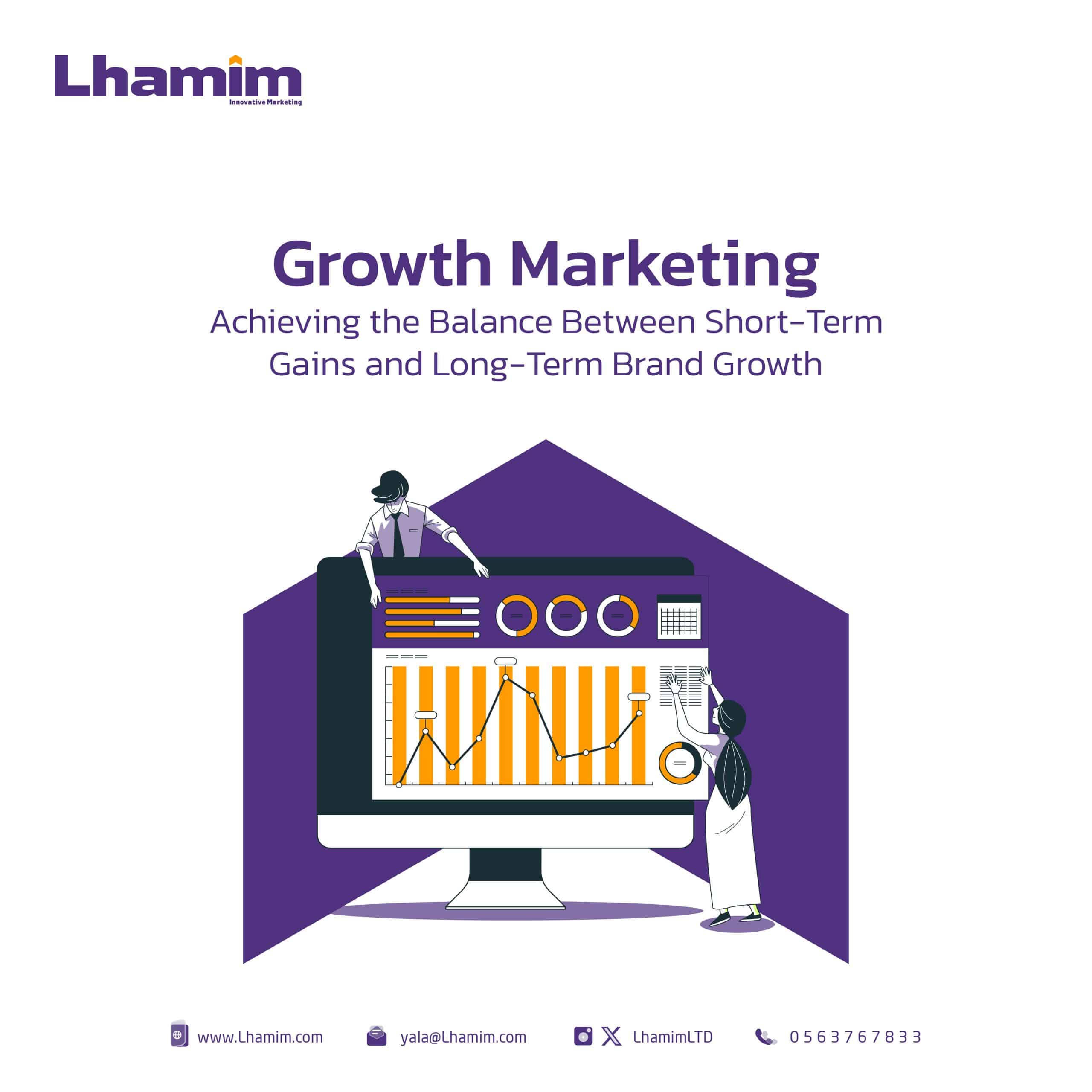In today’s dynamic business landscape, where competition is fierce and consumer behavior is ever-evolving, traditional marketing strategies often fall short in delivering sustainable growth. Enter growth marketing – a data-driven and innovative approach that focuses on scalability, customer engagement, and rapid experimentation. In this comprehensive guide, we will explore how to harness the power of growth marketing to boost sales and enhance your brand’s visibility.

Understanding Growth Marketing
Defining Growth Marketing Growth marketing, often referred to as growth hacking, is an agile and iterative approach that seeks to identify the most effective and efficient ways to achieve growth. Unlike traditional marketing that relies on set strategies, growth marketing thrives on experimentation and continuous improvement.
The Shift from Traditional Marketing While traditional marketing aims to create brand awareness through conventional channels, growth marketing takes a more targeted route. It focuses on finding the right audience, understanding their needs, and delivering a tailored message that resonates deeply.

The Core Principles of Growth Marketing
Data-Driven Decision Making Growth marketing is anchored in data analysis. By leveraging tools like Google Analytics and Mixpanel, marketers gain insights into user behavior, enabling them to make informed decisions that optimize campaigns and strategies.
Continuous Experimentation The heart of growth marketing lies in experimentation. This involves trying out various tactics, analyzing results, and adapting quickly. A/B testing headlines, imagery, and even entire landing pages can reveal what resonates most with your audience.
Customer-Centric Approach Understanding your customers is paramount. Growth marketing involves actively seeking feedback, engaging in conversations, and tailoring experiences to meet customer expectations.
Steps to Implement Growth Marketing Strategies
Step 1: Setting Clear Goals Define specific and measurable goals that align with your brand’s growth objectives. Whether it’s increasing website traffic, boosting conversions, or expanding your customer base, clarity is key.
Step 2: Identifying Your Target Audience Pinpoint your ideal customer. Develop detailed buyer personas that outline demographics, pain points, and preferences. This knowledge forms the foundation of your growth strategy.
Step 3: Analyzing Your Current State Conduct a comprehensive audit of your current marketing efforts. Identify what’s working and what’s not to determine where improvements are needed.
Step 4: Crafting a Unique Value Proposition Differentiates your brand by showcasing a unique value proposition (UVP). Highlight what sets you apart from competitors and resonates with your target audience.
Step 5: Multi-Channel Marketing Leverage various channels such as social media, content marketing, email campaigns, and influencer collaborations. Consistent messaging across platforms enhances brand recognition.
Step 6: A/B Testing and Optimization Constantly test different elements of your marketing campaigns – headlines, images, calls-to-action – and optimize based on the results to maximize impact.
Step 7: Referral Programs and Viral Loops Encourage your existing customers to become advocates. Implement referral programs that reward customers for bringing in new business, creating a powerful viral loop.
Step 8: Customer Retention Strategies Acquiring customers is important, but retaining them is equally crucial. Develop strategies such as personalized communication, loyalty programs, and exceptional customer support.

Measuring Success and KPIs
- Customer Acquisition Cost (CAC)
Calculate how much it costs to acquire a new customer. This metric helps you evaluate the efficiency of your marketing spend.
- Customer Lifetime Value (CLV)
Determine the average revenue generated by a customer throughout their relationship with your brand. This guides decisions on marketing budget allocation.
- Conversion Rate
Measure the percentage of visitors who take the desired action, such as making a purchase or signing up for a newsletter.
- Churn Rate Monitor
How many customers are leaving your brand over a given period. A high churn rate indicates a need to improve customer retention strategies.
Tools for Effective Growth Marketing
- Google Analytics gains insights into website traffic, user behavior, and conversion rates to inform data-driven decisions.
- Mixpanel Analyze user interactions within your app or website, helping refine user experiences.
- Optimizely Perform A/B testing and optimize web experiences to enhance engagement and conversions.
- ReferralCandy Implements referral programs that incentivize customers to refer others, fostering growth through word-of-mouth.
- HubSpot Manage marketing, sales, and customer service in one platform, streamlining customer interactions.

Overcoming Challenges in Growth Marketing
Growth marketing offers incredible opportunities for businesses, but it also presents its fair share of challenges. Here’s how to overcome three critical challenges and ensure the success of your growth marketing endeavors:
Balancing Short-Term and Long-Term Goals
One of the most significant challenges in growth marketing is finding the right balance between short-term wins and long-term sustainability. While growth hacking can deliver rapid results, focusing solely on quick gains can undermine your brand’s overall health. To strike a harmonious balance:
- Prioritize Customer Experience: Ensure that your growth strategies don’t compromise the quality of your products or services. Customer satisfaction should remain a top priority.
- Invest in Brand Building: While immediate conversion is important, invest in brand-building activities that contribute to long-term customer loyalty. This could involve creating valuable content, engaging with customers on social media, and establishing a strong brand identity.
- Segment Your Strategy: Allocate resources for both short-term tactics and long-term strategies. Create a segmented approach that addresses immediate revenue needs while simultaneously nurturing relationships for sustainable growth.
Avoiding Marketing Myopia
Marketing myopia refers to a narrow focus on short-term objectives and tactics, often at the expense of a broader understanding of market trends and customer needs. To avoid this pitfall:
- Embrace a Customer-Centric Mindset: Continuously gather and analyze customer feedback and behavior. This insight helps you remain adaptable and responsive to evolving customer preferences.
- Stay Industry-Aware: Keep an eye on industry trends, emerging technologies, and shifts in customer behavior. This awareness enables you to pivot your strategies in alignment with market changes.
- Focus on Solutions, Not Just Products: Position your brand as a problem solver. Understand the deeper needs of your audience and tailor your offerings to address those needs effectively.
Ensuring Data Privacy and Security
In the era of data-driven marketing, safeguarding customer information and maintaining data privacy are paramount. Failing to prioritize data security can lead to breaches, eroding trust and damaging your brand’s reputation. Here’s how to ensure data privacy and security:
- Compliance with Regulations: Familiarize yourself with data protection regulations relevant to your industry and region. This might include GDPR, CCPA, HIPAA, and others. Ensure your practices are aligned with these regulations.
- Implement Secure Systems: Utilize secure systems for data storage, management, and analysis. Encryption, secure authentication, and regular security audits are essential components of maintaining data security.
- Transparent Communication: Be transparent with your customers about how their data will be used. Obtain explicit consent for data collection and explain how their information contributes to a better experience.
- Regular Training: Train your team members on data security best practices. Establish protocols for data handling, access, and disposal to minimize risks.
Conclusion
Growth marketing presents immense potential for boosting sales and enhancing your brand’s reputation. While navigating challenges is an integral part of the journey, applying a strategic approach to balancing short-term and long-term goals, avoiding marketing myopia, and prioritizing data privacy will set you on a path to sustainable growth and success in the competitive landscape.
Lhamim team presents valuable options to deal with challenges and overcome them, accelerating the growth of your business. We pave your path towards creativity and inspiration through innovative marketing and media campaigns, along with a proven marketing strategy for the growth of your business. Let’s get in touch.

